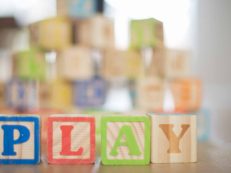1. Curiosity-Driven Play
This is play that arises from the child’s own curiosity. This is how kids learn to explore and to investigate the world around them.
It’s how they learn about cause and effect, about physical relationships between objects, and about rules of all kinds.
2. Discovery-Driven Play
This is when a child has learned enough skills to try something new on his own, without having been taught how to do it.
Children who are ready for this kind of play are often eager to take risks because they know that they can be supported by their parents if things go wrong (even if it involves a lot of tears).
In discovery-driven play, children are learning how to solve problems, follow their own passions, and find the satisfaction that comes from mastering new skills and ideas.
3. Social Play (Peer)
Kids engage in this kind of play with other kids their age (in contrast with social play with adults).
Social play helps kids develop their social skills (like sharing) as well as prepare them for interactions with other people in their lives — friends, teachers, relatives, strangers — both now and later in life.
It also helps them build self-confidence because they know that they can rely on others when needed (even if those others are younger or smaller than they are).
4. Imaginative Play
This is when kids play with toys and other objects in a way that helps them build their imagination. Kids can use props and materials to make up stories and tell their own versions of them.
They can use the same props and materials to re-enact something they’ve seen on TV or in a book.
They can act out stories from history or from books they’ve read. The possibilities are endless!
This kind of play helps kids learn how to use their imaginations, which is essential for developing creativity, problem-solving skills, curiosity, confidence, self-awareness, and more.
It also helps them build relationships with other people (like family members or friends) because it gives them a chance to act out parts of the story with others in ways that help everyone understand what’s going on better.
5. Cooperative Play (Peer)
In this kind of play, kids work together to accomplish something that would be too difficult for any one child to do alone (for example, building a block tower).
This kind of play also allows children to practice sharing with each other (even if sharing is not always perfect!).
It also helps kids learn how to take turns doing things (like taking turns being the one who uses the big tower blocks).
Cooperation requires some planning as well as shared responsibility for making sure that everyone has an equal chance to contribute — which is an important skill in life!
- 6. Fantasy Play (Peer)
Kids use props and materials in imaginative ways when they are playing fantasy games like “dress up” or “pretend cooking” or “pirate ship” or “mermaid palace” or whatever else their imagination comes up with!
Fantasy play helps kids develop their creativity and imagination, learn how to role-play, practice new social skills.
Get comfortable interacting with others in pretend scenarios, imagine new possibilities for themselves — all kinds of wonderful things! It’s also great fun! 🙂
7. Physical Play (Peer)
Kids engage in this kind of play when they are running, jumping, climbing, swinging, playing tag, and so on.
They also engage in physical play when they are making up games with props and materials that require a lot of physical activity (like using toys to re-enact a race car accident or something like that).
Physical play helps kids develop their gross motor skills (which is important for movement later in life), learn how to follow rules about how to interact with others during physical activities (like the rules of tag).
Also, to gain self-confidence because they know that they can do things like climb a tree or jump over obstacles.
8. Purposeful Play
This is when kids use props and materials to help them practice something they have been taught by an adult — for example, sorting things into groups or counting objects.
This kind of play helps kids learn the skills that will be important for them later in life (like math skills or social skills).
9. Creative Play
This is when kids use props and materials to create something new on their own — without having been taught how to do it. This kind of play helps kids learn how to be creative and how to solve problems creatively.
It also helps them develop self-confidence because they know that if they can’t solve a problem the first time around, they can try again until they get it right!
10. Deliberate Play (With Adults)
This is when kids use props and materials in ways that help them practice what adults have taught them. For example, practicing cutting with scissors or practicing spelling words from a list of words an adult has made up for them.
This kind of play helps kids build on what they have already learned from adults about certain skills. Such as cooking or painting or coloring — so that those skills become second nature instead of being difficult for them later on in life!
When it comes to your child's well-being, it's best to consult with a professional. To lower the chances of getting inaccurate information or hearing a misconception about a child's growth. It is highly recommended that you conduct preliminary research. Cudy Marketplace is here to help you to connect with the professional counselor easily.






